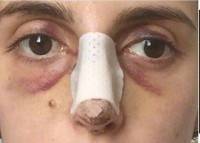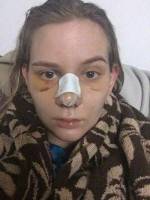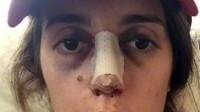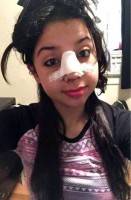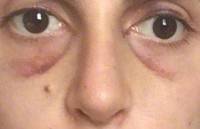Rhinoplasty Recovery Month By Month
After a rhinoplasty, patients wear an external splint on their nose for 7 days. Internal splints may also be required and they are generally worn for 7 days, too. These splints help minimize swelling and also help keep the nose in proper position as it heals. Once the splint is removed, we typically ask patients to continue wearing it at night for another 7 days.
As far as how a rhinoplasty feels post-op, patients typically report it feels similar to having the flu, with a congested nose that forces you to breathe through your mouth. Though the nose feels congested, patients are asked not to blow their noses for at least three weeks after the surgery.
During this time, the patient will also have some swelling and bruising around the eyes that can be helped with ice packs and which generally resolves over a period of 1 to 2 weeks, though minor swelling may persist up to several months.
Once a patient’s splint is removed, they will notice immediate changes in the appearance of their nose. However, there will be some swelling. The healing process is gradual so a patient might not see the ultimate result of their surgery until a few months later.
In the meantime, they will experience significant stuffiness that can last anywhere from a few weeks to a few months. Some patients return to work or school a couple of days after surgery, even though they are still swollen, bruised and wearing their splint.
Most patients return to normal activity within a week. Your physician and his or her staff can advise you on how to use cosmetics to mask the appearance of bruising on your face and can also tell you how to properly clean your face as you heal. (Deason Dunagan, MD, Huntsville Plastic Surgeon)
Recovery after rhinoplasty
There is rarely any pain after the surgery. Most of my patients do not take any pain medication after the operation. You will have a bandage on your nose for one week and some black and blue under your eyes that lasts a week to ten days.
I will ask you not to do any vigorous exercise for three weeks, but you will be able to do all of your normal activities beginning the day after the operation.
You will see most of the results when the bandage comes off, but you may not see the final result in refinement of the tip of your nose for a few months after the operation. (Howard T. Bellin, MD (retired), Manhattan Plastic Surgeon)
There are some generally accepted guidelines for recovery after rhinoplasty. Typically there is an initial swelling and bruising process that lasts four to ten days. You can be socially acceptable after five to six days.
You should keep your head elevated for two weeks to minimize swelling and maximize healing. 95% of your result will be evident at six weeks. The final result will be manifest at six to nine months. (Talmage J. Raine, MD, Champaign Plastic Surgeon)
Rhinoplasty and recovery
The recovery process varies from patient to patient depending on their exact surgical needs. In general your nasal splint will be on for approximately six days. You may or may not have bruising under the eyes if you do these can take anywhere from a week to two weeks to go completely away.
Most of the time these are easily concealed with make up for my female patients. Most patients return to work after the first seven to ten days. You will need to stay away from a work out schedule for several weeks and avoid any trauma to the nose. (Michael Elam, MD, Orange County Facial Plastic Surgeon)
Rhinoplasty Recovery and What to Expect and How to Optimize Yours
Basic tips for planning and preparing for your rhinoplasty and optimizing your recovery:
- Good lifestyle – a healthy balanced diet with adequate protein and a multivitamin setup your body for healing after surgery.
- Be realistic – understand that there is no such thing as a perfect result, and that there is always a some possibility that you will have unfavorable results or need some sort of revision
- Time off – allow adequate time off for your initial recovery (typically 5-15 days for non-strenuous work environments, depending on your level of tollerance for looking like you had an operation)
- Swelling – I typically remove internal and external splints at 6 days and follow this with 1-2 weeks of self-taping of the nose at night to help reduce swelling
- Length of time for Swelling 2 weeks – 80% of swelling is gone, 6 weeks – 90% of swelling is gone, but tip swelling is typically still present. The last 10% takes up to 12 months to go away fully.
- Massage – we have incorporated lymphatic massage into the first visit at 6 days to help reduce swellings
- Moisturization – this is your homework assignment: do not let the nose dry out and have crusts form. We give out a nasal rinse kit to help you keep the nose clean and moist on the inside.
- Other things to consider: Bruising and “black eyes” are possible, and if you experience this, it may take two weeks or more to fully go away. Pain is usually not severe. As with nearly any surgery, you are expected to walk several times each day after surgery.
Return to more vigouros physical activity is generally started around week three. (Nick Slenkovich, MD, Denver Plastic Surgeon)
Most patients can return to work in about 10-14 days after nose job surgery. Everyone will develop some level of swelling, bruising, and nasal congestion depending on the type of nose job.
Nasal congestion improves siginificantly after the first week though you will still have some for the first 3 weeks. Everyone bruises differently; some people don’t bruise at all and other bruise for 3 weeks but on average, most people have 10-14 days of bruising; as a result, most patients feel presentable after this time period.
Most nasal swelling dissipates after 2 weeks and 80% of the swelling will have resolved by 4 weeks; another 10% will dissipate after 2-3 months and the remainder generally takes a full year to resolve.
After the initial 2 week period, however, most people will not notice the swelling remaining in your nose. (Mike Majmundar, MD, Atlanta Facial Plastic Surgeon)
The recovery from a nose job is completely subject to the amount of work that you’ve had done. If it isn’t much then the recovery can be as short as a few days.
If you needed the bones rearranged and some cartilage grafting then is may be as long as a couple of weeks before you’re ready to do anything relatively demanding.
You should expect sutures to be removed at a week and sometimes a splint will be needed to be removed at 2 weeks. The swelling will persist for a long time after that.
That doesn’t mean that everybody sees that swelling. You will, and it usually is in the tip of the nose, but it just takes a while to go away until you can see the actual artistic result of the operation. (Ricardo A. Meade, MD, Dallas Plastic Surgeon)
It’s not so bad as long as you are highly motivated and patient. If you are anxious and nervous, you will experience more pain. Usually, the splint comes off at 7 days, and you are back to work in 10 days.
Your nose will still be swollen to some extent for months, but usually no one will notice. The question of how long does it take to heal is a very good one. We tell patients that your nose will improve slowly over the first 18 months, but really some changes continue for about the first 3-4 years.
The nose job is designed to continue to look good as you age. (Stuart H. Bentkover, MD, Boston Facial Plastic Surgeon)
Nose job recovery
I recommend planning 4-5 days off from work. An important caveat, though is that some patients may have black eyes. Avoid any activity that will raise your blood pressure for 2 weeks post-nose job. I also advise abstaining from high impact activities (jumping, running) for 6 weeks after nose job. I usually leave an external splint for four- to five- days. It normally will take almost 18 months before you see the final shape of your new nose. (Paul C. Zwiebel, MD, Denver Plastic Surgeon)
The evening of surgery-mostly sleeping and icing.
- Day 2 to 3: walking around in the house, watching TV, sedentary
- Day 4 to 7: walking in the back yard, doing phone and computer work
- Day 7: Splint comes off the nose. Back to work.
- Day 8 to 14: Walking for exercise
- Day 14 to 21: Running for exercise
- Day 21 onwards: Weight lifting and all other exericses. (Tanveer Janjua, MD, Bedminster Facial Plastic Surgeon)
Normal course for nose job recovery
- After nasal surgery, you can expect the following:
- Nasal splint on the outside of the nose for 1 week
- Possible bruising (black eyes) – if present, will be visible for 2 to 3 weeks
- Bothersome swelling inside the nose for 2-4 weeks
- Swelling / edema notable to others for 1 month
- Swelling visible for you and your surgeon for 1 year.
- The final result of the nose job will not be present until a year has passed. (Michael A. Bogdan, MD, FACS, Dallas Plastic Surgeon)
Although it may take 6 months or more to fully recovery a patient can usually be in public within 1 to 2 weeks, and start light exercise at 3 to 4 weeks.
It takes about 6 weeks for the bone to firm up but injury can occur beyond that. (Richard O. Gregory, MD, Orlando Plastic Surgeon)
The typical recovery time for nose surgery is 7 days in a splint. Then 6 weeks of mild swelling.
Ultimately, it takes up to one year for all of the swelling to go away (especially, at the tip). So it does require patience.
Just choose your board-certified plastic surgeon, carefully and make sure that they are an expert in rhinoplasty. (Dustin L. Reid, MD, Austin Plastic Surgeon)
Five to seven days of downtime for nose surgery
Most patients say that the post operative period is much easier than they thought it would be. Few have difficulty with pain.
There is a period of nasal stuffiness due to internal swelling that usually goes away in 7 to 10 days. We usually recommend no heavy exercise for 2 weeks but allow post surgical patients to start up on a treadmill one week after surgery.
Most people take a week off of work but those who are type A are always itching to get back to work. The main hinderance is the external nasal splint which is usually an obvious sign that surgery was done.
So if the person doesn’t mind going to work with a nasal splint on, we have many people who may go back to work after 4 or 5 days.
Bruising is rare in most of our patients, especially if they refrain from taking blood thinners such as aspirin, advil, high doses of Vitamin E, Ginger, Ginseng, Gingko Biloba or Garlic pills for 2 weeks before surgery up to 2 weeks after surgery.
In the rare occassion, a bruise occurs we recommend Auridern, a topical cream of Vitamin K oxide), which we have found very helpful to quickly remove the bruising. After the splint comes off, the nose is a bit swollen, usually much more so if an open approach was used.
We recommend taping the nose with 3M paper tape quarter inch over the tip for the first few weeks at night. It seems to keep the tip well defined and the swelling down.
As far as diet, within the first week there really is no restrictions. And showering is ok as long as the splint doesnt get too wet. For a primary nose surgery (for a person having their first nose reshaping procedure), most people are back to routine social and work activities in 7 days and surprisingly it is rare for anyone to know what they did.
You would think people look so closely at you but the truth is most don’t. We frequently hear from our patients that their friends and acquantances are unsure why they look better. They usually attibute it to a new hair style, vacation, or being better rested. (Steven H. Dayan, MD, Chicago Facial Plastic Surgeon)
Nose surgery recovery time
Typical recovery for a nose surgery is about a week. You will have a cast on the outside of your nose that stays in place for the entire week. It is not so much a painful procedure as it is annoying because your breathing is not optimal through your nose at that point.
I encourage my patients to take it easy including not doing any heavy lifting(anything heavier than a gallon of milk). Bruising can be variable and depends on several factors. After the cast comes off your nose will be swollen and this will continue to come down over a couple weeks.
Healing continues for up to a year where minimal changes will occur to the nose. A majority of the swelling will subside over about a 2 week time period. The remainder will slowly subside and this largely depends on the extent of surgery and the thickness of the nasal skin. I remind my patients consistently that they need to regularly follow up with me during this time to monitor the nose for any changes and address any concerns. (Michael T. Somenek, MD, FACS, Washington DC Facial Plastic Surgeon)
Very important question if you are considering nose surgery. I usually advise patients to take two weeks off after surgery. By two weeks, most of the important milestones will have been reached in the healing process:
- The bruising and most of the facial swelling should have resolved so that you will not have the telltale signs of recent surgery from a conversational distance.
- The incisions should have healed and scar treatment can begin.
- Breathing through the nose should be getting easier although it can take several weeks to improve.
- You will be able to see an early result although the final result can take 12 months or so for all the swelling to subside! (William Townley, MD, FRCS(Plast), London Plastic Surgeon)
